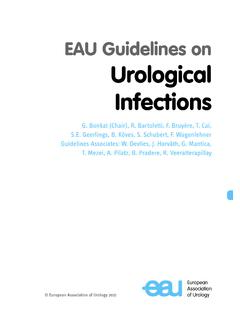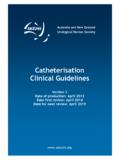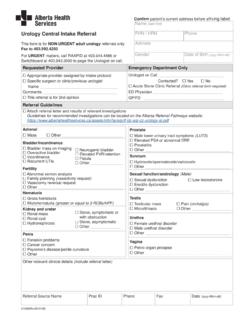Transcription of EAU Guidelines on the Assessment of Non-neurogenic Male ...
1 EUROPEAN UROLOGY 67 (2015) 1099 1109. available at journal homepage: Platinum Priority Guidelines Editorial by Jean-Nicolas Cornu and Bertrand Lukacs on pp. 1110 1111 of this issue EAU Guidelines on the Assessment of Non-neurogenic Male lower Urinary Tract Symptoms including Benign Prostatic Obstruction Christian Gratzke a, Alexander Bachmann b, Aurelien Descazeaud c, Marcus J. Drake d, Stephan Madersbacher e, Charalampos Mamoulakis f, Matthias Oelke g, Kari Tikkinen h, Stavros Gravas i,*. a b Department of Urology, Urologische Klinik und Poliklinik, Klinikum der Universita t Mu nchen-Grosshadern, Munich, Germany; Department of Urology, University Hospital Basel, Basel, Switzerland; c Department of Urology, Dupuytren Hospital, University of Limoges, Limoges, France; d Bristol Urological Institute and School of Clinical Sciences, University of Bristol, Bristol, UK; e Department of Urology and Andrology, Kaiser-Franz-Josef Spital, Vienna, Austria.
2 F Department of Urology, University General Hospital of Heraklion, University of Crete Medical School, Heraklion, Crete, Greece; g Department of Urology, Hannover Medical School, Hannover, Germany; h Departments of Urology and Public Health, Helsinki University Central Hospital and University of Helsinki, Helsinki, Finland; i Department of Urology, University of Thessaly, Larissa, Greece Article info Abstract Article history: Context: lower urinary tract symptoms (LUTS) represent one of the most common Accepted December 26, 2014 clinical complaints in adult men and have multifactorial aetiology. Objective: To develop European Association of Urology (EAU) Guidelines on the assess- ment of men with Non-neurogenic LUTS. Keywords: Evidence acquisition: A structured literature search on the Assessment of non- Clinical practice Guidelines neurogenic male LUTS was conducted.
3 Articles with the highest available level of Diagnosis evidence were selected. The Delphi technique consensus approach was used to develop the recommendations. lower urinary tract symptoms Evidence synthesis: As a routine part of the initial Assessment of male LUTS, a medical Bladder outlet obstruction history must be taken, a validated symptom score questionnaire with quality-of-life Benign prostatic hyperplasia question(s) should be completed, a physical examination including digital rectal exami- Detrusor overactivity nation should be performed, urinalysis must be ordered, post-void residual urine (PVR). should be measured, and uro owmetry may be performed. Micturition frequency- Overactive bladder volume charts or bladder diaries should be used to assess male LUTS with a prominent Nocturia storage component or nocturia.
4 Prostate-speci c antigen (PSA) should be measured only Nocturnal polyuria if a diagnosis of prostate cancer will change the management or if PSA can assist in decision-making for patients at risk of symptom progression and complications. Renal function must be assessed if renal impairment is suspected from the history and clinical examination, if the patient has hydronephrosis, or when considering surgical treatment for male LUTS. Uro owmetry should be performed before any treatment. Imaging of the upper urinary tract in men with LUTS should be performed in patients with large PVR, haematuria, or a history of urolithiasis. Imaging of the prostate should be performed if Please visit this assists in choosing the appropriate drug and when considering surgical treatment.
5 Urethrocystoscopy should only be performed in men with LUTS to exclude suspected europeanurology to read and bladder or urethral pathology and/or before minimally invasive/surgical therapies if the answer questions on-line. ndings may change treatment. Pressure- ow studies should be performed only in individual patients for speci c indications before surgery or when evaluation of the The EU-ACME credits will pathophysiology underlying LUTS is warranted. then be attributed automatically. * Corresponding author. Department of Urology, University of Thessaly, Feidiou 6 8, Larissa 41221, Greece. Tel. +30 69 44626086; Fax: +30 24 13501900. E-mail address: (S. Gravas). 0302-2838/# 2014 European Association of Urology. Published by Elsevier All rights reserved.
6 1100 EUROPEAN UROLOGY 67 (2015) 1099 1109. Conclusions: These Guidelines provide evidence-based practical guidance for assess- ment of Non-neurogenic male LUTS. An extended version is available online (www. ). Patient summary: This article presents a short version of European Association of Urology Guidelines for Non-neurogenic male lower urinary tract symptoms (LUTS). The recommended tests should be able to distinguish between uncomplicated male LUTS and possible differential diagnoses and to evaluate baseline parameters for treatment. The Guidelines also de ne the clinical pro le of patients to provide the best evidence-based care. An algorithm was developed to guide physicians in using appro- priate diagnostic tests. # 2014 European Association of Urology.
7 Published by Elsevier All rights reserved. 1. Introduction Cochrane databases between 1966 and October 1, 2013, including the search terms lower urinary tract symptoms'', lower urinary tract symptoms (LUTS) represent one of the benign prostatic hyperplasia'', detrusor overactivity'', most common clinical complaints in adult men [1]. The overactive bladder'', nocturia'', and nocturnal polyuria''. prevalence of LUTS increases with age, and estimates vary in combination with the prespecified diagnostic tests and widely depending on definitions and cohorts studied the search limits humans'', adult men'', review'', [1,2]. LUTS have a major impact on health-related quality randomised clinical trials'', clinical trials'', and meta- of life (QoL) [2] and are associated with substantial personal analysis''.
8 Each extracted article was separately analysed, and societal costs [3]. classified, and labelled with a level of evidence (LE). LUTS can be divided into storage, voiding, and post- according to a classification system modified from the micturition symptoms, and have traditionally been related Oxford Centre for Evidence-based Medicine, ranging from to bladder outlet obstruction (BOO) as a result of benign systematic reviews of randomised trials (LE 1a, highest prostatic obstruction (BPO), which is often caused by benign evidence level) to expert opinion (LE 4, lowest evidence prostatic enlargement (BPE) resulting from the histologic level) (modified from [5]). condition benign prostatic hyperplasia (BPH) [4]. Several The working panel used the Delphi technique consensus recent studies have shown, however, that LUTS are not approach, which is based on the rationale that decisions necessarily related to pathologies of the prostate.
9 For captured systematically from a structured group of instance, various types of bladder dysfunction may also be individuals (the working panel) are more valid than those involved in the pathogenesis of LUTS, which is sometimes from unstructured groups. When published information is urodynamically manifest as detrusor overactivity (during scarce, experts can make inferences using other data from the storage phase) or underactivity (during the voiding [( )TD$IG]. phase). In addition, many other conditions, both urological and nonurological, may also contribute to LUTS (Fig. 1). Benign prostatic OAB obstruction Scope and purpose of the Guidelines (detrusor And others overactivity) .. Owing to the high prevalence of LUTS and the underlying multifactorial pathophysiology, accurate Assessment of Nocturnal Distal ureteral polyuria male LUTS is crucial to establish a differential diagnosis stone among possible causes and to define the clinical profile of men with LUTS to provide the best evidence-based care (overall objectives).
10 The Assessment should be able to Detrusor Bladder identify patients for whom watchful waiting (WW) or underactivity LUTS tumour medical or surgical treatment can be recommended, as well as men at risk of disease progression, and to assess patients'. values and preferences. The Guidelines aim to answer the neurogenic clinical question as to which tests are recommended in the bladder Urethral dysfunction stricture Assessment of Non-neurogenic LUTS in men aged 40 yr and when these tests should be performed. Urinary tract Prostatitis infection 2. Evidence acquisition Foreign body The recommendations in these Guidelines are based on a structured literature search for articles published in English Fig. 1 Causes of male lower urinary tract symptoms (LUTS).













